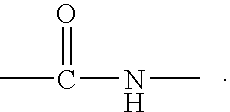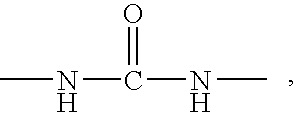Block polyorganosiloxane block organomer polymers and release agents
a technology of organomer polymer and polyorganosiloxane, which is applied in the direction of electrostatographic process, instruments, coatings, etc., can solve the problems of unfavorable final product electrostatographic process quality, unfavorable toner offset, and unfavorable toner offs
- Summary
- Abstract
- Description
- Claims
- Application Information
AI Technical Summary
Benefits of technology
Problems solved by technology
Method used
Image
Examples
example 1
[0252] 5.67 grams of Unicid.RTM.700 were combined with 94.33 grams of PS513a, and blended at 175.degree. C. for 3 hours. 35.2 grams of the resulting product were combined with 764.8 grams of 60,000 cSt DC200.RTM. oil, and blended at room temperature.
example 2
[0253] 0.81 grams of stearic acid were combined with 40 grams of PS513b at 80-85.degree. C., until the resulting melt was completely blended, about 30 minutes total. No precipitation of stearic acid was observed on cooling. 20 grams of the resulting product were oven baked at 175.degree. C. for 7 hours to prepare the polymer. 17.6 grams of this product were combined with 382.4 grams of 60,000 cSt DC200.RTM. oil, and blended at room temperature.
example 3
[0254] 1.17 grams of stearic acid were combined with 40 grams of PS513b at 80-85.degree. C., until the resulting melt was completely blended. No gross precipitation of the stearic acid was observed on cooling; a slight haze was noted. 20 grams of the resulting product were oven baked at 175.degree. C. for 7 hours to prepare the polymer. 17.6 grams of this product were combined with 382.4 grams of 60,000 cSt DC200.RTM. oil, and blended at room temperature.
PUM
| Property | Measurement | Unit |
|---|---|---|
| temperature | aaaaa | aaaaa |
| density | aaaaa | aaaaa |
| operating temperatures | aaaaa | aaaaa |
Abstract
Description
Claims
Application Information
 Login to View More
Login to View More - R&D
- Intellectual Property
- Life Sciences
- Materials
- Tech Scout
- Unparalleled Data Quality
- Higher Quality Content
- 60% Fewer Hallucinations
Browse by: Latest US Patents, China's latest patents, Technical Efficacy Thesaurus, Application Domain, Technology Topic, Popular Technical Reports.
© 2025 PatSnap. All rights reserved.Legal|Privacy policy|Modern Slavery Act Transparency Statement|Sitemap|About US| Contact US: help@patsnap.com



